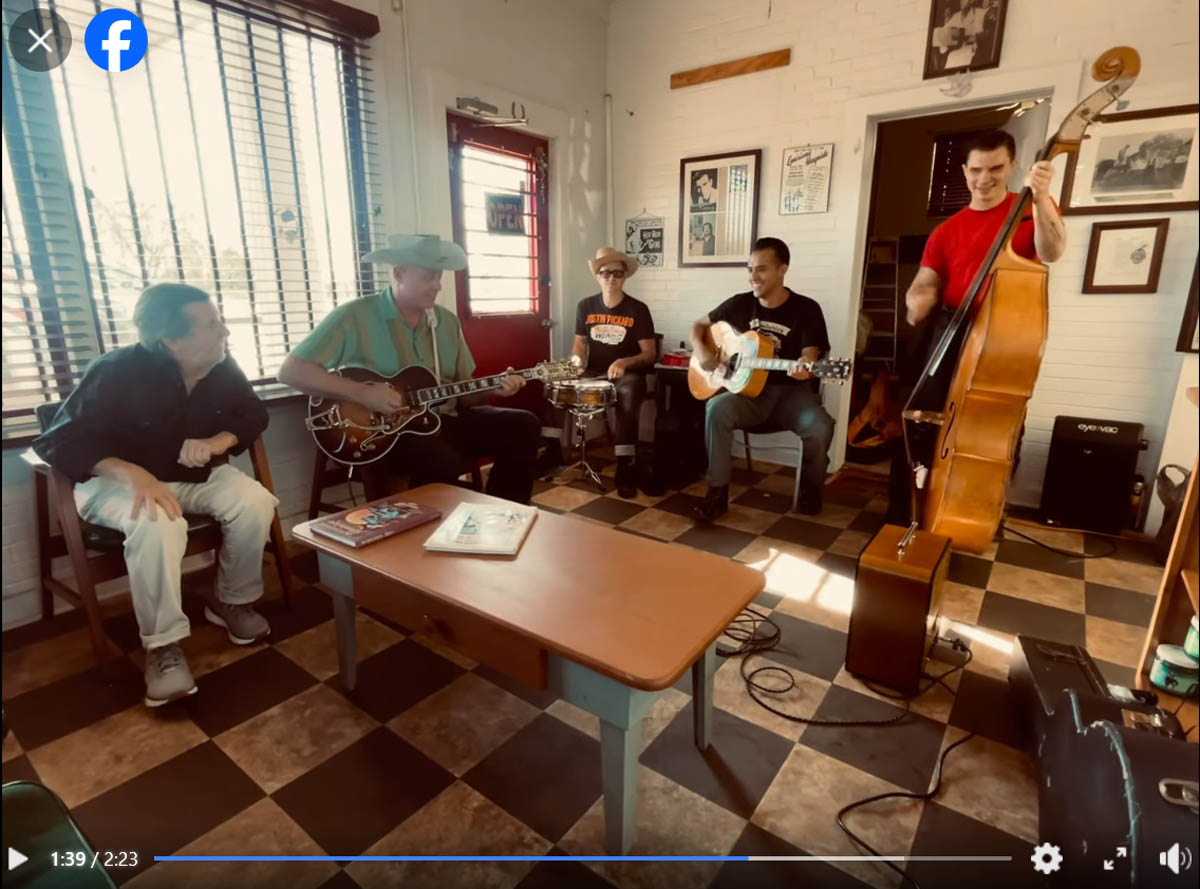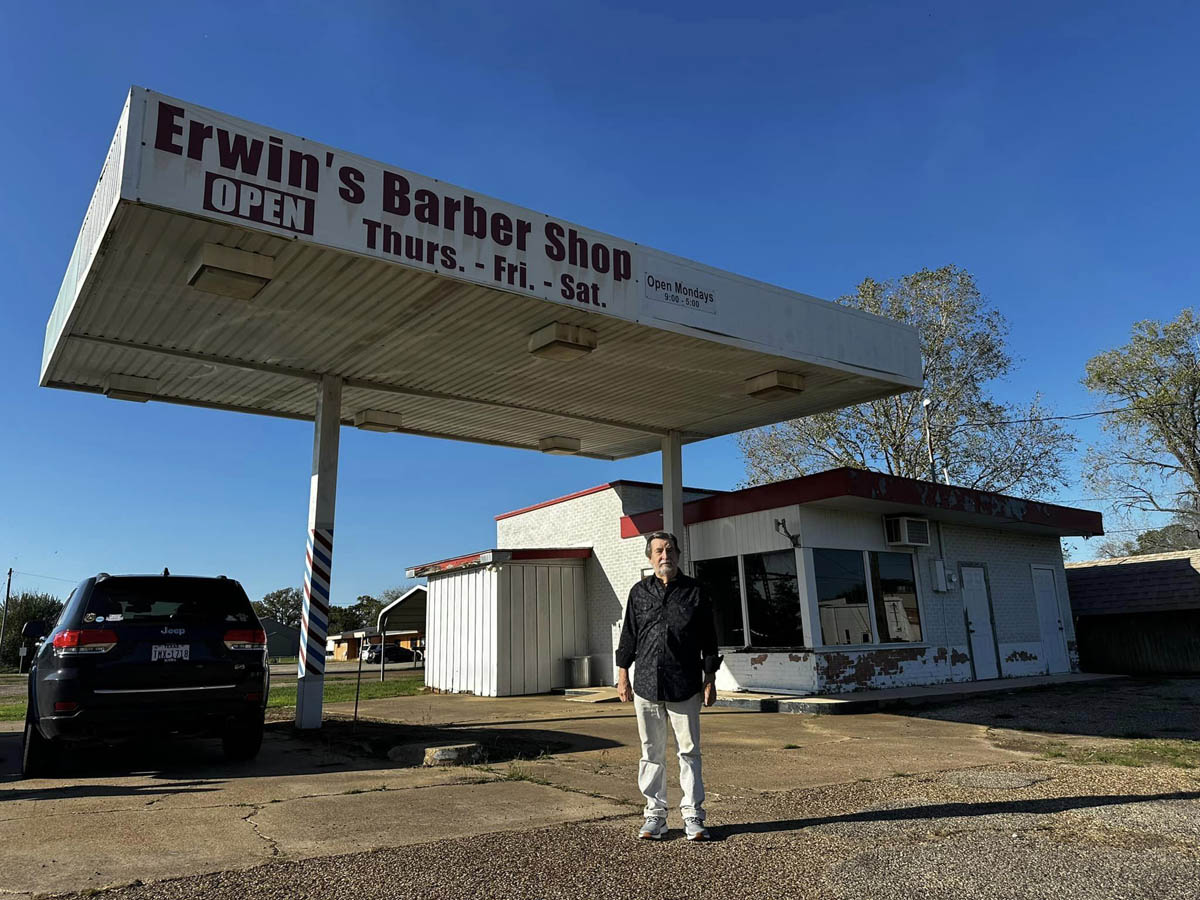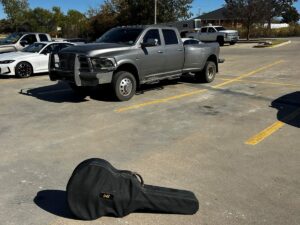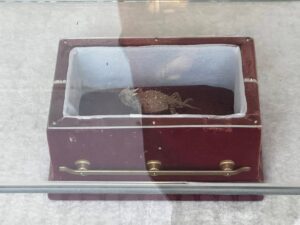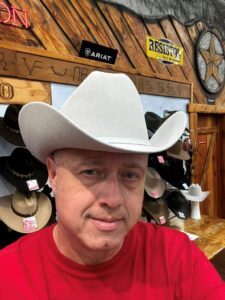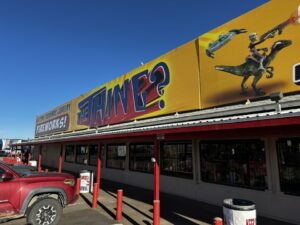What a great afternoon! We took a side trip to Alba, Texas, to go hang out with 1950s rockabilly legend Sid King! Sid is 88 years old and still doing great. We talked about the old days, we played a little music for him (we begged him to sing with us, but he politely declined), and took a bunch of photos in his barber chair (Sid has been a barber since the band dissolved in 1957). Big thanks to Dallas-area disc jockey and music historian Jamey Brains for setting up the visit! If you aren’t familiar with Sid’s music, do yourself a favor and listen to some Sid King and the Five Strings today! One of the greatest rockabillies of the 1950s!
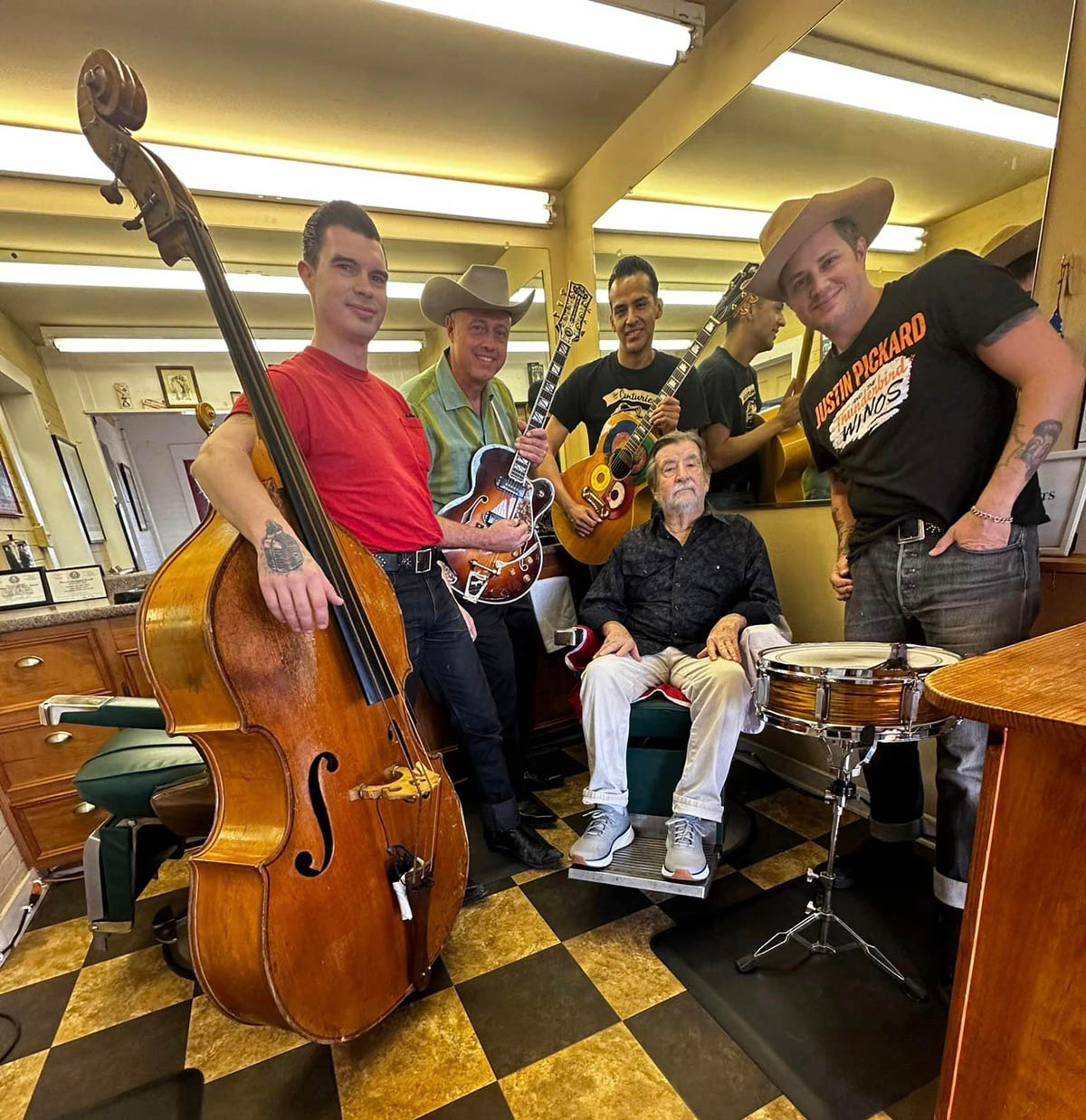

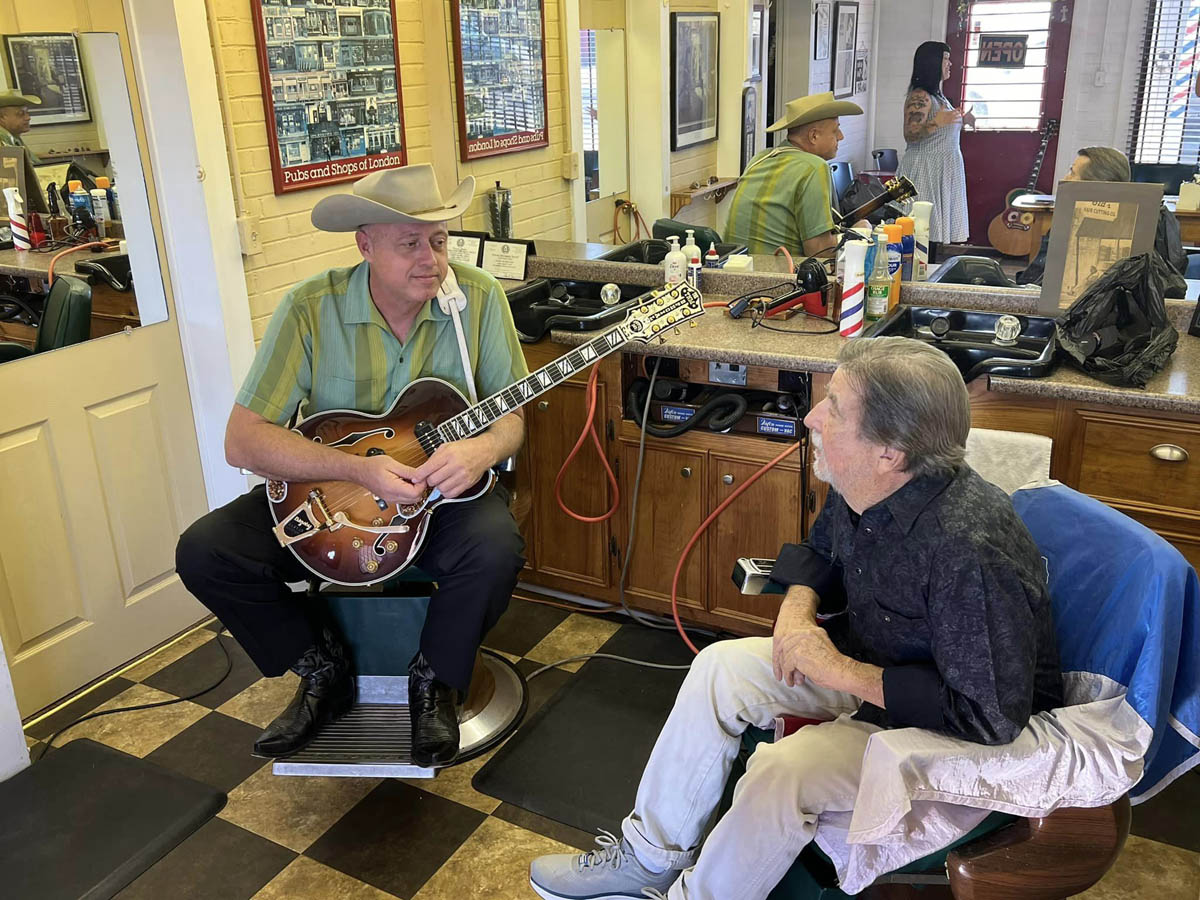
Deke’s pal Jamey Brains added some info and additional photos of Sid and their day together. Read on for his commentary, and hit the image at the end to link to a video of Sid looking on as Deke and the Whippersnappers perform one of the best-known Five Strings tunes, “Sag, Drag, and Fall.”
In 1952 a group of Denton junior high students from Texas formed a band known as Western Melody Makers. A humble hometown beginning afforded the boys a laid-back authenticity in the heyday of rock and roll history.
“My momma was our biggest fan,” says Sid. She singlehandedly raised Sid and Billy, after their father, a professional jockey, was killed in an accident on the track. Sid’s mother was trackside at the time of the accident, holding Sid on her hip and Billy in her belly. Despite the tragic shift in the family dynamic, Mrs. Erwin never faltered in her devotion to providing her boys with a loving, supportive home. Music ran in the family—Sid’s mother was a fiddler and pianist. She purchased Sid and Billy their first guitars for Christmas one year, and that was that. Mrs. Erwin’s support for her sons’ creative pursuits was made evident through intricately hand-sewn costumes—two sets each. In the collars of the hand-sewn stagewear she made for the boys were handwritten nametags, helping to eliminate dressing room confusion and backstage brotherly brawling.
(Their early 1950s Western stagewear arrived at Sid’s barbershop in East Texas following the 2019 passing of his brother and lead guitarist, Billy Erwin. The items survived being stowed away in Billy’s shed for several decades—a far cry from the stages of the Louisiana Hayride, Ozark Jubilee, and Big D Jamboree.)
Hank Williams Sr., Lefty Frizzell, Faron Young, and Ray Price inspired the boys’ musical interests early on. Country served a fine musical foundation, but they wanted more. The boys were drawn to an upbeat swing, with a little more get-up-and-go than found in a 3/4 country waltz. Aside from the country crooners, the boys also fancied their rhythm and blues records.
Although Sid says, “We were too rock for country and too country for rock,” the time was right for the group to dive headfirst into the teen frenzy of the rock ’n’ roll movement kick-started in the public eye by Elvis Presley in 1954.
In 1954 The Western Melody Makers signed with Starday Recording Studio out of Beaumont, Texas. Sid recalls that the Starday recordings “sounded horrible.” The brothers, displeased but not deterred, soon signed with Columbia after Don Law saw them perform and offered the band a contract. At this time, the band’s name changed to Sid King and the Five Strings.
Decades after crossing paths at Starday, Sid spotted George Jones in the audience at a performance in a Dallas banquet hall. During the set break, Sid approached George and asked if he remembered him. “Well, sure I do!” replied George, and he promptly began singing the chorus of “Who Put the Turtle In Myrtle’s Girdle?”
Between 1954 and 1955, Sid King and the Five Strings began headlining the Big D Jamboree every three months, headlining with acts such as Elvis Presley. (For reference to Elvis’s status at this time, Elvis had just recorded and released what quickly became one of his most iconic hits, “Heartbreak Hotel.”) Upon meeting Elvis backstage for the first time at the Big D Jamboree, Elvis shook Sid’s hand, saying, “Sid, I heard your records and sure thought y’all was older.” But then again, Elvis said, “People hear me on the radio and think I’m colored!”
“Rockabilly” was but a blip of time on the music history radar, lasting only four or five years. By the time it fizzled out, Sid could no longer take care of his growing family on the income from the once-thriving circuit. In 1958 he traded his guitar for clippers and became a barber, and in 1965 he opened a barbershop in Richardson, Texas.
Beatlemania put this first wave of rock ’n’ roll to bed, only to be startled from slumber by overseas fanfare in the late 1970s, causing a second wave of musical notoriety known as “the rockabilly revival.” The second wave of fame came as a significant surprise to Sid, as it would for anyone whose career goes comatose, only to be suddenly revived with an eclectic electric jolt decades later. Sid first learned of the revival after receiving a phone call asking if he’d like to get back in the studio and record. Sid didn’t take long to reach a verdict, and shortly after that, Sid and brother Billy were headed overseas for season 2 of their music career.
The years following would offer a strange sight to behold. Sid recalled looking out the front window of his Richardson barbershop: “These guys looked like delinquents, with their rolled-up jeans, greasy hair, and flashing cameras.” The globetrotters Sid speaks of came from all over the world during the rockabilly revival years. These fans had musical monuments in their sightseeing plans, often including Graceland, Sun Studio—and Sid King’s modest barbershop. The fans were overwhelmed with excitement, while Sid was overwhelmed with humble confusion.
As recently as 2018, Sid King and the Five Strings headlined Tom Ingram’s Viva Las Vegas weekender. These days, performing hangs a daunting prospect for Sid following the death of lead guitar player and beloved little brother, Billy Erwin. “The stage just wouldn’t feel right.”
Sid is now eighty-eight years old, happily retired (yet keeping busy) in Alba, Texas, alongside his junior high sweetheart. His barbershop and recording studio are in a 1940s petrol station, the lobby walls adorned with photos of his musical heroes, along with posters and other memorabilia from performances over the decades.
Hope y’all dig this history bit and photos/videos from our visit!
Watch the video at the original post!
